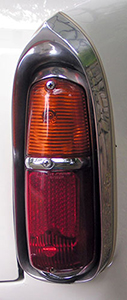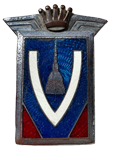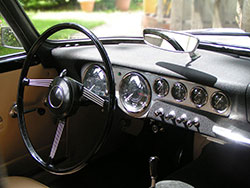Production, sort of . . .
With approximately 45 cars spread between the prototypes, the show cars and the TSF Italias, that leaves about 255 cars for the 'production' run. Rare by any standards, more so today.
If you found your way here from the Restoration section you might be surprised to see #126 again. As the most original of any of the surviving "production" cars, it is the best example to use in this section.
Lots of details to enthrall fellow Italia enthusiasts while boring the pants off any non-car fanatics who'll listen.
Exterior
Lights
Front parking light and turn signals were Altissimmo with four separate housings and pointed lenses. The lenses were most often clear but some export models used amber for the turn signal. There appear to be a couple of possible styles with one more pointed than other. Only the Second Prototype used rectangular front parking lights.

For the rear, aluminum taillight housings with Lucas 523 lenses were used on cars for export out of Italy. That lens was also used on Alfa's, Lancia's and the Austin/Nash Metropolitan. More common, were aluminum housings with one upper, internal "ledge" to help locate the light fixture using Altissimo and/or early Carello lenses. These were mounted with the amber side up. We believe Altissimo was taken over by Carello as the lenses are almost identical. The internal reflector and letter were different between the two. Lastly, chromed, cast pot metal taillight housings with two locating "ledges" (upper and lower) for the late Carello lenses. The late Carello were mounted with the red on top and have a circular external reflector. All three were also used on the Lancia Appia Vignale. #126 uses the earlier Altissimo style.
All the production cars featured small, round, orange side marker lights on the front wings. Keep in mind that the holes were not always drilled in exactly the same spot from car to car. The round style is now readily available and inexpensive since they were used on many FIATs. This makes it easier to identify the TSF Italias as this light is mounted very high on the fender. Please note that the long tear drop shape seen on one or two cars was a later interchange made by owners missing the originals. None of the period photos of the Italia show it with the tear drop style.
Badges
The badges had become standardized on the "production" cars. "Italia 2000" on the nose and trunk (boot) lid, the "Vignale" cloisonné badge on both front fenders (wings), "T.M. Triumph" and the crossed "Vignale/Standard-Triumph" flags on the rear fenders. Vignale liked maritime themes and these are naval flags. These are a "V" and an "S." We scratched our heads a bit on the "S." But it stands for "Standard-Triumph." Similar badges appeared on the Standard-Vanguard Vignale and the Herald. We have also discovered that the "T.M." on the rear wing badge stands for "Telaio e Motori," translating to "Chassis and Engine."
Later in production, the style of the "Italia 2000" and the "T.M. Triumph" was slightly modified. This happened between Italia #194 and #195. But nothing Italia is ever that simple and for a few cars around #220, they must have found some left over earlier badges. The spacing of the mounting holes is different.
One variation was the occasional appearance of a small "Styled by G. Michelotti" badge on the boot handle. Not all cars have this. If there are no holes in the boot handle then the badge was not installed. This badge was "gold" plated to stand out against the chrome.







Side trim
The bars along the side were made from aluminum. These mounted along the bottom edge of the door (not on the sills) and were fastened using machine screws that fit in a channel in the aluminum. This was done so that the screws could be positioned to fit the drilled holes and the bar positioned correctly. There were three sections, on the front wings, along the door edge and a very short piece at the front of the rear wings.
Boot handle
The boot handle/license light configuration on #126 is unusual. It is a mix of the long handle of the early cars which has an integrated light for the license plate and the later light housing mounted on a plinth around the trunk latch, below the opening. This light was also used on Maseratis and Alfa 2600s.
Both Italia #129 and #134 have the later small handle but with a light mounted directly on the bumper. After this, production settled on the late handle and a lower light mounted on an eschutcheon below the boot lid.
Earlier production cars used only the long handle.
Fuel (Petrol) tank
We can narrow down the introduction of the outside fuel filler and its unusual tank to between #228 and #233. #227 has an internal filler and #234 has the outside filler.
License plate
As the major market was Europe, the space for the rear license plate is square. The plate itself was fastened with three stamped stainless steel trim sections. The front plate was a small rectangle and mounted on a stamped mounting plinth made to fit in the center of the front bumper.
Bumpers
Bumpers remained the same through the show car and production run. These were made from chrome-plated steel. The front was one piece with two overriders (bumperettes). The rear bumper was made in three sections. The center section could be adjusted to fit the width of the body. The rear also used two overriders. All four were made to fit their specific location on the car. The front overriders were deeper than the ones used on the rear.
The bumpers were also the same design as used on the Lancia Appia Vignale. The Lancia is a wider car and the center section of the rear bumper could be adjusted to fit. Even though the shape was basically the same as the Italia's, the Lancia front bumper was made specifically to fit that car and is too wide to use on an Italia without modifications.
Interior
Seats
The front seat pattern has a slightly lower center section on the base and back giving a slight bolster. The rear seat was plain with no inner stitching. The front seats in later cars, after about #153, have longitudinal stitching across both faces.
Door panels
The door panels are made in two pieces with the short lower section allowing for differences in the door height. The panels had an incorporated map pocket and were fastened to the door with screws.
There are aluminum caps at the top edge of the doors and also at the top edge of the rear quarter panels. These were always painted black except on the show cars where some were in white.
The TSF series door panels are one-piece and do not use the caps.
Dashboard

The instruments and switches are standard TR3. The exceptions are the ignition switch, glove box lock, the heater fan switch (FIAT 600) and the three warning lights. These lights are Italian in origin and have been used in many cars from the period. The ignition switch is of the usual "turn to start type" not the "turn and push" style.
The cars have a manual pump for the windshield washer also used in a FIAT 850 and many other period Italian cars.
The aluminum grab handle appears in the Italia and the Lamborghini 350GT. The door latch and window winder handles are also used in the Lancia Appia Vignale.
Interior lights
The Italia also sports two interior lights, one in each of the kick panels near the doors. This is an Italian manufactured light used in Alfas, Maseratis and Ferraris. It is available from various sources. The actuating switch, which resides in the door jamb, featured black plastic for the button and a chromed housing. Replacements are readily available but are generally cadmium or nickel-plated with a slightly different black or white button.
There is a map light mounted on the lower lip under the dash. This is Italian in origin and was used in the FIAT 1100-103. There is a small change to this lamp mid-range with a ribbed lens. Lastly, in the TSF cars, there is an Alfa Romeo light that matches the door lights but with a switch. This last style didn't require cutting the dashboard which makes it easier to tell whether or not it was on a particular Italia.
Just inside the front door at the top of the jamb, is an extra aluminum finishing strip to cover the "A" pillar vinyl.
Rear seat
At the back of the rear seat is an additional stainless trim piece covering the seam between the seat back and the parcel shelf. There is a chrome trim strip along the rear parcel shelf behind the rear seat. This panel is steel and screwed to the body work along the base of the rear window. There are also two mounting holes through which pass the mounts for the rear seat back top section. This arrangement holds the complete seat back in place. Unlike the TR4, there is an access panel to the rear differential under the back seat.
Headliner
The headliner is vinyl with perforated holes. I have seen both white and on later cars, a light shade of gray.











